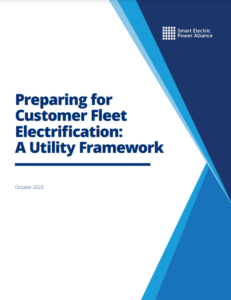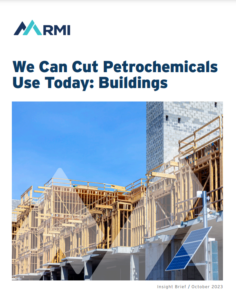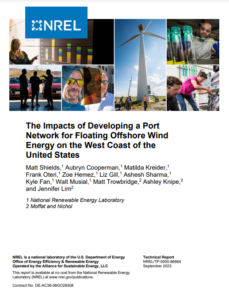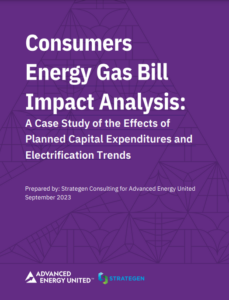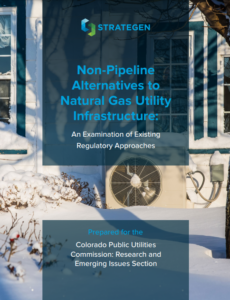The OurEnergyLibrary aggregates and indexes publicly available fact sheets, journal articles, reports, studies, and other publications on U.S. energy topics. It is updated every week to include the most recent energy resources from academia, government, industry, non-profits, think tanks, and trade associations. Suggest a resource by emailing us at info@ourenergypolicy.org.
Resource Library
Electric fleets are not on the horizon but rather at our doorstep. The U.S. EV industry is growing rapidly year over year, with U.S. EV sales expected to grow from 1 million vehicles in 2022 to over 1.6 million in 2023.[1] As this shift places increasing demands on electricity, utilities play a crucial role in facilitating this electrification transition. The Utility Fleet Electrification Framework report offers valuable insights for utilities and fleet operators and delves into the complex dynamics between utilities, fleet operators, and charging providers, providing guidance on achieving a smooth electrification transition through a combination of utility and …
View Full ResourceThe objective of the Photovoltaic Stormwater Management Research and Testing (PVSMaRT) project was to develop and disseminate research-based, solar-specific resources for estimating stormwater runoff at ground-mounted PV facilities and detail stormwater management and water quality best practices. These resources and best practices are aimed at reducing the balance of system soft costs associated with stormwater infrastructure requirements and improving water quality outcomes through research-tested best practices.…
View Full ResourceThe World Bank’s development projects aim to help promote economic growth, reduce poverty, and achieve better living standards. Such projects, however, can disrupt the lives of those living in and near project areas. These disruptions can affect the environment and communities, be positive or negative, temporary or permanent. Development projects, especially those relating to infrastructure, sometimes create impacts that can require timely and appropriate mitigation and adaptation.
This report discusses some of the issues, challenges and complexities based on recent World Bank Inspection Panel cases associated with livelihood restoration resulting from the taking of land or restrictions of access to …
The purpose of this report is to equip wind industry professionals with the fundamental information needed to best leverage additive manufacturing techniques in their design and manufacturing decisions. Herein an overview of each of the seven families of additive manufacturing is provided, along with typical materials used in each process, current ranges on process speeds, materials and system costs, and examples of systems on the market today. Using the lens of large-scale additive to suit the needs of the wind industry, the processes that are well-suited to large-scale production are down selected from the seven families and additional information with …
View Full ResourceRMI’s report We Can Cut Petrochemicals Use Today: Buildings provides an overview of the use of petrochemicals in the construction and renovation of buildings in the United States and what steps can be taken to lower buildings’ embodied emissions based on petrochemical use efficiency.
Most building material efficiency efforts focus on reducing concrete and steel use; however, buildings’ walls, floors, insulation, and siding use an outsized portion of global commodity plastics and other key petrochemicals.
This report details the actions decision makers should prioritize to lower buildings’ embodied emissions due to petrochemical use and thereby mitigate health, fossil-resource, and carbon …
View Full Resource“Developing a system of ports that can enable commercial-scale floating offshore wind energy development on the West Coast of the United States will require significant investment and coordination between governments, industry, port authorities, and local communities. A critical first step to strategically planning these resources is understanding the number of ports (and associated investment) that would be required to support different phases of offshore wind energy project development, including manufacturing, installation, and operation. But simply tallying up these costs is not sufficient to understand how a robust network of ports could impact local communities, the environment, workforce development, the offshore …
View Full ResourceThe analysis in this report demonstrates that over the next several decades, Consumers Energy’s residential customer gas rates will steadily increase due to projected utility capital expenditures and electrification trends. The total potential bill increases that Consumers’ residential customers may experience, due to capital expenditures and electrification, trends up to approximately 49% by 2030.
In light of these trends, to safeguard the public interest and protect vulnerable customers from being unduly burdened by an overbuilt gas system, public policy must evolve to adequately scrutinize new capital investments in the gas distribution system.…
View Full ResourceThe primary audience of this paper is public utility commissions (PUCs) that are considering the role of NonPipeline Alternatives (NPAs) in gas utility planning. The purpose of this paper is to examine the existin proceedings, rules, and studies that are currently or have been under consideration to inform PUCs as they consider developing their own NPA frameworks. This is the first of two papers on the topic of non-pipeline alternatives. The second will address best practices in the construction of an NPA framework.…
View Full ResourceIn May 2021, the IEA published its landmark report Net Zero Emissions by 2050: A Roadmap for the Global Energy Sector. The report set out a narrow but feasible pathway for the global energy sector to contribute to the Paris Agreement’s goal of limiting the rise in global temperatures to 1.5 °C above pre-industrial levels. The Net Zero Roadmap quickly became an important benchmark for policy makers, industry, the financial sector and civil society.
Since the report was released, many changes have taken place, notably amid the global energy crisis triggered by Russia’s invasion of Ukraine in February 2022. And …
View Full ResourceThe Breakthrough Agenda Report 2023 is an annual collaboration between the International Energy Agency (IEA), the International Renewable Energy Agency (IRENA) and the United Nations Climate Change High-Level Champions, focused on supporting stronger international collaboration to drive faster reductions in global greenhouse gas emissions. This year’s report shows that current efforts on clean energy and sustainable solutions, while improving, are not yet delivering the levels of investment and deployment required to meet international climate goals. In response, it calls on governments to strengthen collaboration in key areas – such as standards and regulation, financial and technical assistance and market creation …
View Full Resource